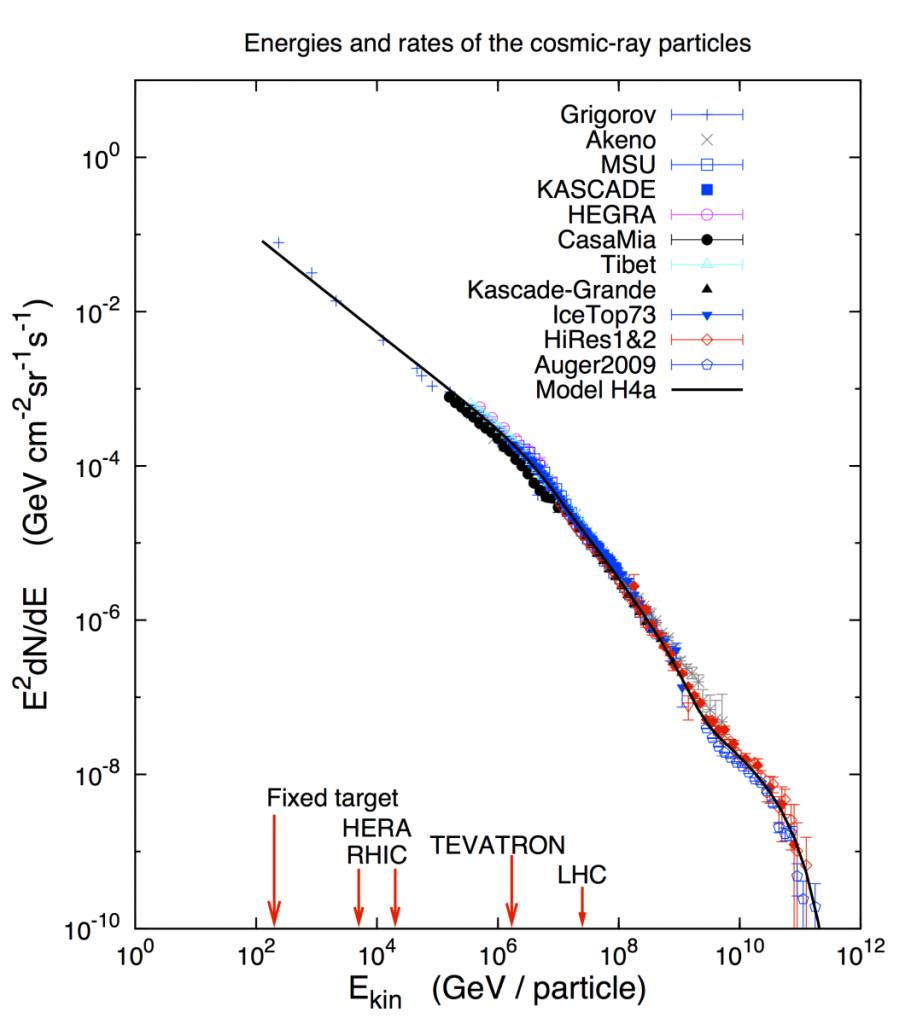»»» ![]() shows where students could discuss/think about a topic/concept.
shows where students could discuss/think about a topic/concept. ![]() shows where an activity is introduced. »»»
shows where an activity is introduced. »»»
IceCube is a multipurpose detector that allows scientists to address several open questions in modern physics, such as the nature of dark matter or neutrino oscillations. But, the main reason for building this detector was to search for very high energy neutrinos, which can help us understand the origin and nature of cosmic rays.
A large part of the radiation of our Universe does not come from stars but from more extreme objects powered by black holes and neutrons stars, such as supernovas, pulsars, and gamma-ray bursts. These objects can accelerate particles, called cosmic rays, to energies over one million times those reached by today’s particle accelerators on Earth.

Since the 1960s, scientists have speculated that these powerful environments also produce neutrinos, which can be used to explore the universe—just as light is used by optical telescopes. But it was soon realized that a cubic-kilometer-sized detector was required to do this science.
IceCube, the South Pole neutrino observatory, is the first detector of this kind, designed to observe neutrinos from the most violent astrophysical sources in our Universe.
Remember: IceCube detects neutrinos with energies generally above 50 GeV. As a rule of thumb, we can think about neutrinos with energies below a few TeV to be most probably atmospheric in origin, i.e., produced by the collisions of cosmic rays with the atmosphere. And those with energies above several TeV to be more likely produced in extraterrestrial sources.
But we can also think about IceCube as a huge muon detector, since it mostly detects muons, about a million for each observed neutrino. Most of these muons are also produced by the interaction of cosmic rays with the Earth’s atmosphere.
How can we select only those neutrinos coming from beyond the Solar System?
Scientists usually refer to all the signals in a detector that they are not interested in for a given analysis as “background.” And they keep the word “signal” for the information that they are looking for.
In this masterclass analysis, our signals are from those neutrinos created by the same cosmic generators that have created cosmic rays, and the vast background is mostly composed of atmospheric neutrinos and muons.
![]() Selection criteria. Which characteristics of the events observed in IceCube can be used to separate signal from background?
Selection criteria. Which characteristics of the events observed in IceCube can be used to separate signal from background?
Hint. Think about parameters such as energy, direction, or shape of the events as seen by IceCube. This display can help you guess some of the important properties to consider.
Learn how the selection was done by IceCube researchers (see more details here for “Event Selection,” page 7).
![]() Looks simple, right? Let’s see how good you are trying to guess how this selection works. Particle Quiz: selecting neutrinos in IceCube.
Looks simple, right? Let’s see how good you are trying to guess how this selection works. Particle Quiz: selecting neutrinos in IceCube.
The starting track analysis: A search for very high energy neutrinos in IceCube
That’s how a recent analysis published by the IceCube Collaboration in Science approached this problem: they searched for a flux of very high energy neutrinos by looking at those events that started in the IceCube detector.
If a flux was found, it would be the first flux of very high energy neutrinos ever measured. Two questions would need to be answered:
1) Are these neutrinos produced beyond our Solar System?
2) Can we point to the exact source(s) where they were created?
Let’s take a look at the events that were selected.
Among a few million events detected in IceCube from May 2010 to May 2012, 28 very high energy neutrino events were found. Only those events that started within the detector and with a reconstructed energy over 30 TeV were selected. A subsequent analysis that included a third year of data found 37 very high energy neutrino events.
![]() Take a first look at the 37 neutrino events. Can you guess which ones had the highest energy?
Take a first look at the 37 neutrino events. Can you guess which ones had the highest energy?
![]() Now, take your time. Here is a closer look at the 37 neutrinos, with some information about each of them.
Now, take your time. Here is a closer look at the 37 neutrinos, with some information about each of them.
Let’s now address the questions we raised above. How can we know if these events came from beyond our Solar System? ![]()
Hint. The IceCube team includes theoretical and experimental physicists.
![]() Let’s define the properties of our neutrino flux and produce graphics and charts of them. Think about why/if this signal is compatible with background events. Look at the data vs simulation distributions and learn how they change when we modify the selection energy cut.
Let’s define the properties of our neutrino flux and produce graphics and charts of them. Think about why/if this signal is compatible with background events. Look at the data vs simulation distributions and learn how they change when we modify the selection energy cut.
Are we sure this is an extraterrestrial high-energy neutrino flux? Can we tell how significant this result is? ![]()
Hint. Think about how more statistics could improve our signal, and if we made an important hypothesis, how that could be shown to be totally or partially incorrect.
![]()
![]() Now we are ready to address the second question: Can we point to the source(s) where these neutrinos were produced?
Now we are ready to address the second question: Can we point to the source(s) where these neutrinos were produced?
Congratulations! You were able to reproduce a particular research finding of the IceCube Collaboration, published in Science in November, 2013.
Further information:
Read the news about this analysis on the IceCube website.
IceCube: A Giant Frozen Neutrino Catcher, blog post by Matt Strassler.


